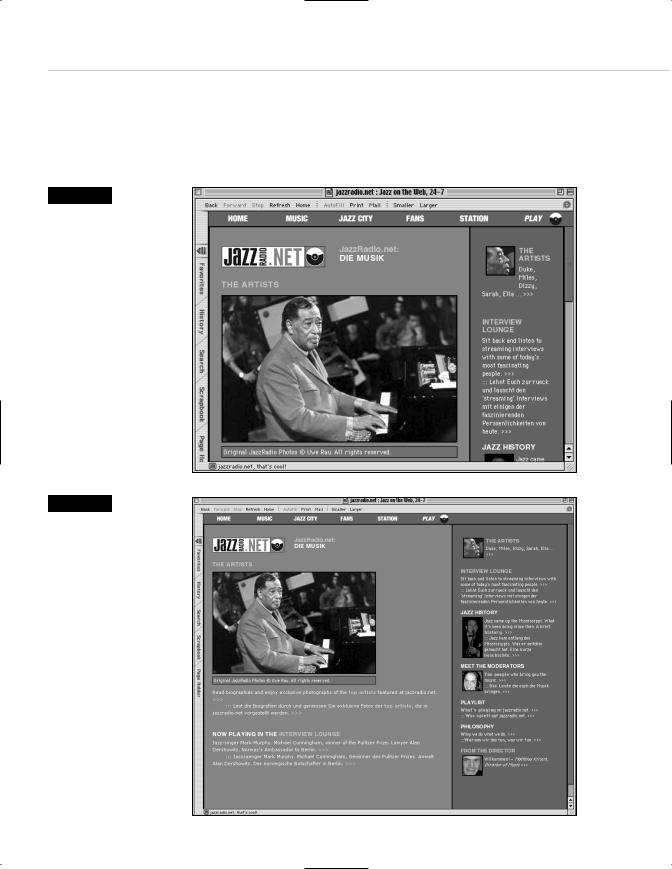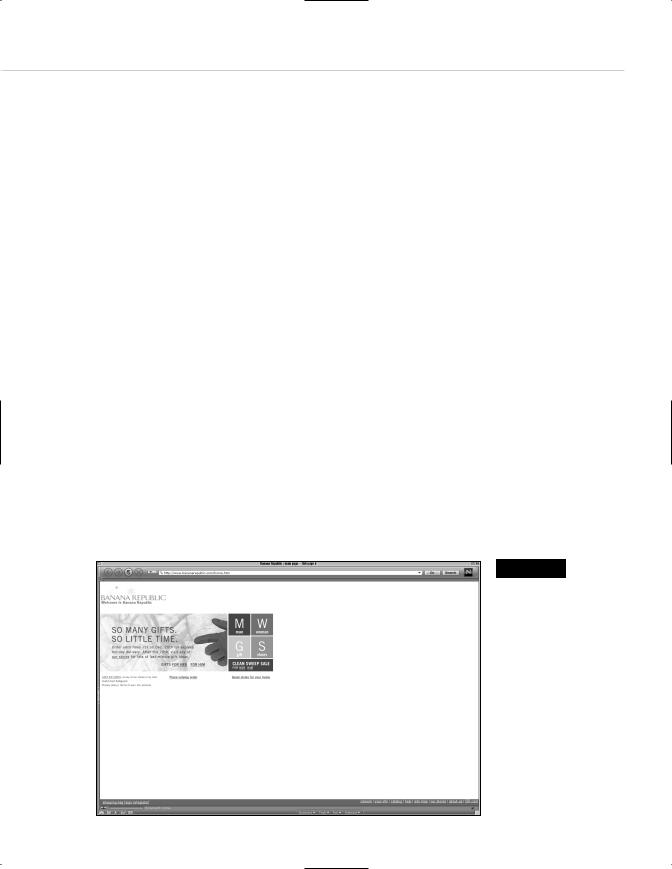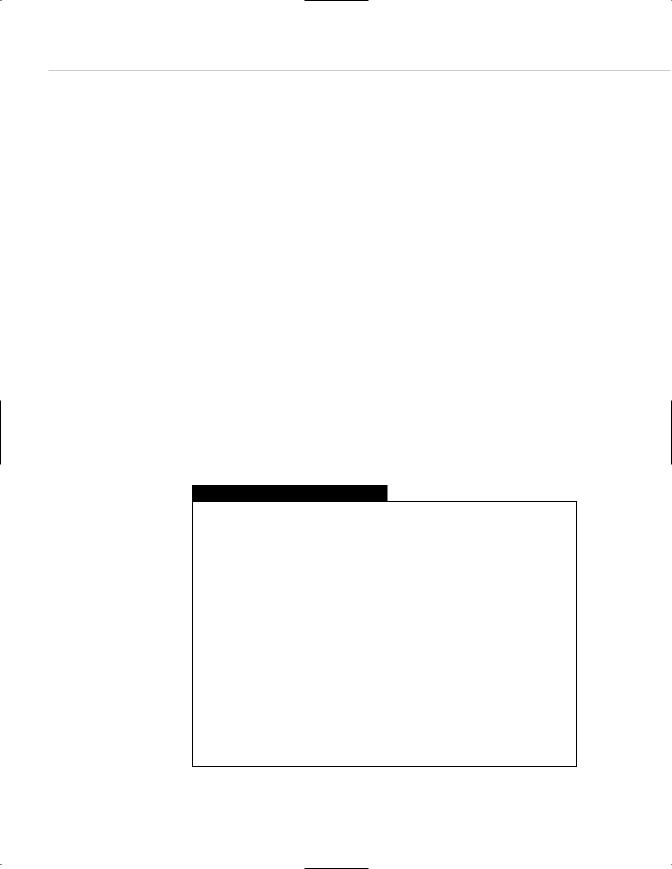
- •Taking Your Talent to the Web
- •Introduction
- •1 Splash Screen
- •Meet the Medium
- •Expanding Horizons
- •Working the Net…Without a Net
- •Smash Your Altars
- •Breath Mint? Or Candy Mint?
- •Where’s the Map?
- •Mars and Venus
- •Web Physics: Action and Interaction
- •Different Purposes, Different Methodologies
- •Web Agnosticism
- •Point #1: The Web Is Platform-Agnostic
- •Point #2: The Web Is Device-Independent
- •The 18-Month Pregnancy
- •Chocolatey Web Goodness
- •’Tis a Gift to Be Simple
- •Democracy, What a Concept
- •Instant Karma
- •The Whole World in Your Hands
- •Just Do It: The Web as Human Activity
- •The Viewer Rules
- •Multimedia: All Talking! All Dancing!
- •The Server Knows
- •It’s the Bandwidth, Stupid
- •Web Pages Have No Secrets
- •The Web Is for Everyone!
- •Swap text and code for images
- •Prune redundancy
- •Cache as Cache Can
- •Much Ado About 5K
- •Screening Room
- •Liquid Design
- •Color My Web
- •Thousands Weep
- •Gamma Gamma Hey!
- •Typography
- •The 97% Solution
- •Points of Distinction
- •Year 2000—Browsers to the Rescue
- •Touch Factor
- •Appropriate Graphic Design
- •User Knowledge
- •What Color Is Your Concept?
- •Business as (Cruel and) Usual
- •The Rise of the Interface Department
- •Form and Function
- •Copycats and Pseudo-Scientists
- •Chaos and Clarity
- •A Design Koan: Interfaces Are a Means too Often Mistaken for an End
- •Universal Body Copy and Other Fictions
- •Interface as Architecture
- •Ten (Okay, Three) Points of Light
- •Be Easily Learned
- •Remain Consistent
- •Continually Provide Feedback
- •GUI, GUI, Chewy, Chewy
- •It’s the Browser, Stupid
- •Clarity Begins at Home (Page)
- •I Think Icon, I Think Icon
- •Structural Labels: Folding the Director’s Chair
- •The Soul of Brevity
- •Hypertext or Hapless Text
- •Scrolling and Clicking Along
- •Stock Options (Providing Alternatives)
- •The So-Called Rule of Five
- •Highlights and Breadcrumbs
- •Consistent Placement
- •Brand That Sucker!
- •Why We Mentioned These Things
- •The year web standards broke, 1
- •The year web standards broke, 2
- •The year web standards broke, 3
- •The year the bubble burst
- •5 The Obligatory Glossary
- •Web Lingo
- •Extranet
- •HTML
- •Hypertext, hyperlinks, and links
- •Internet
- •Intranet
- •JavaScript, ECMAScript, CSS, XML, XHTML, DOM
- •Web page
- •Website
- •Additional terminology
- •Web developer/programmer
- •Project manager
- •Systems administrator (sysadmin) and network administrator (netadmin)
- •Web technician
- •Your Role in the Web
- •Look and feel
- •Business-to-business
- •Business-to-consumer
- •Solve Communication Problems
- •Brand identity
- •Restrictions of the Medium
- •Technology
- •Works with team members
- •Visually and emotionally engaging
- •Easy to navigate
- •Compatible with visitors’ needs
- •Accessible to a wide variety of web browsers and other devices
- •Can You Handle It?
- •What Is the Life Cycle?
- •Why Have a Method?
- •We Never Forget a Phase
- •Analysis (or “Talking to the Client”)
- •The early phase
- •Design
- •Brainstorm and problem solve
- •Translate needs into solutions
- •Sell ideas to the client
- •Identify color comps
- •Create color comps/proof of concept
- •Present color comps and proof of concept
- •Receive design approval
- •Development
- •Create all color comps
- •Communicate functionality
- •Work with templates
- •Design for easy maintenance
- •Testing
- •Deployment
- •The updating game
- •Create and provide documentation and style guides
- •Provide client training
- •Learn about your client’s methods
- •Work the Process
- •Code Wars
- •Table Talk
- •XHTML Marks the Spot
- •Minding Your <p>’s and q’s
- •Looking Ahead
- •Getting Started
- •View Source
- •A Netscape Bonus
- •The Mother of All View Source Tricks
- •Doin’ it in Netscape
- •Doin’ it in Internet Explorer
- •Absolutely Speaking, It’s All Relative
- •What Is Good Markup?
- •What Is Sensible Markup?
- •HTML as a Design Tool
- •The Frames of Hazard
- •Please Frame Safely
- •Framing Your Art
- •<META> <META> Hiney Ho!
- •Search Me
- •Take a (Re)Load Off
- •WYSIWYG, My Aunt Moira’s Left Foot
- •Code of Dishonor
- •WYS Is Not Necessarily WYG
- •Publish That Sucker!
- •HTMHell
- •9 Visual Tools
- •Photoshop Basics: An Overview
- •Comp Preparation
- •Dealing with Color Palettes
- •Exporting to Web-Friendly Formats
- •Gamma Compensation
- •Preparing Typography
- •Slicing and Dicing
- •Rollovers (Image Swapping)
- •GIF Animation
- •Create Seamless Background Patterns (Tiles)
- •Color My Web: Romancing the Cube
- •Dither Me This
- •Death of the Web-Safe Color Palette?
- •A Hex on Both Your Houses
- •Was Blind, but Now I See
- •From Theory to Practice
- •Format This: GIFs, JPEGs, and Such
- •Loves logos, typography, and long walks in the woods
- •GIFs in Photoshop
- •JPEG, the Other White Meat
- •Optimizing GIFs and JPEGs
- •Expanding on Compression
- •Make your JPEGS smaller
- •Combining sharp and blurry
- •Animated GIFs
- •Creating Animations in ImageReady
- •Typography
- •The ABCs of Web Type
- •Anti-Aliasing
- •Specifying Anti-Aliasing for Type
- •General tips
- •General Hints on Type
- •The Sans of Time
- •Space Patrol
- •Lest We Fail to Repeat Ourselves
- •Accessibility, Thy Name Is Text
- •Slicing and Dicing
- •Thinking Semantically
- •Tag Soup and Crackers
- •CSS to the Rescue…Sort of
- •Separation of Style from Content
- •CSS Advantages: Short Term
- •CSS Advantages: Long Term
- •Compatibility Problems: An Overview
- •Working with Style Sheets
- •Types of Style Sheets
- •External style sheets
- •Embedding a style sheet
- •Adding styles inline
- •Fear of Style Sheets: CSS and Layout
- •Fear of Style Sheets: CSS and Typography
- •Promise and performance
- •Font Size Challenges
- •Points of contention
- •Point of no return: browsers of the year 2000
- •Absolute size keywords
- •Relative keywords
- •Length units
- •Percentage units
- •Looking Forward
- •11 The Joy of JavaScript
- •What Is This Thing Called JavaScript?
- •The Web Before JavaScript
- •JavaScript, Yesterday and Today
- •Sounds Great, but I’m an Artist. Do I Really Have to Learn This Stuff?
- •Educating Rita About JavaScript
- •Don’t Panic!
- •JavaScript Basics for Web Designers
- •The Dreaded Text Rollover
- •The Event Handler Horizon
- •Status Quo
- •A Cautionary Note
- •Kids, Try This at Home
- •The Not-So-Fine Print
- •The Ever-Popular Image Rollover
- •A Rollover Script from Project Cool
- •Windows on the World
- •Get Your <HEAD> Together
- •Avoiding the Heartbreak of Linkitis
- •Browser Compensation
- •JavaScript to the Rescue!
- •Location, location, location
- •Watching the Detection
- •Going Global with JavaScript
- •Learning More
- •12 Beyond Text/Pictures
- •You Can Never Be Too Rich Media
- •Server-Side Stuff
- •Where were you in ‘82?
- •Indiana Jones and the template of doom
- •Serving the project
- •Doing More
- •Mini-Case Study: Waferbaby.com
- •Any Size Kid Can Play
- •Take a Walk on the Server Side
- •Are You Being Served?
- •Advantages of SSI
- •Disadvantages of SSI
- •Cookin’ with Java
- •Ghost in the Virtual Machine
- •Java Woes
- •Java Woes: The Politically Correct Version
- •Java Joys
- •Rich Media: Exploding the “Page”
- •Virtual Reality Modeling Language (VRML)
- •SVG and SMIL
- •SMIL (through your fear and sorrow)
- •Romancing the logo
- •Sounds dandy, but will it work?
- •Promises, Promises
- •Turn on, Tune in, Plug-in
- •A Hideous Breach of Reality
- •The ubiquity of plug-ins
- •The Impossible Lightness of Plug-ins
- •Plug-ins Most Likely to Succeed
- •Making It Work: Providing Options
- •The “Automagic Redirect”
- •The iron-plated sound console from Hell
- •The Trouble with Plug-ins
- •If Plug-ins Run Free
- •Parting Sermon
- •13 Never Can Say Goodbye
- •Separation Anxiety
- •A List Apart
- •Astounding Websites
- •The Babble List
- •Dreamless
- •Evolt
- •Redcricket
- •Webdesign-l
- •When All Else Fails
- •Design, Programming, Content
- •The Big Kahunas
- •Beauty and Inspiration
- •Index

Taking Your Talent to the Web |
51 |
SCREENING ROOM
Luxuriating in your monitor’s 21” screen, you design a site that looks sensational. How will it look on a 14” screen? Will it even fit? That is the challenge of screen resolution.
Screens range from 14” to 21” (and higher), with 15” and 17” currently the most popular. By the time this book is printed, 17” screens will dominate the home market, and ladies named Mistress Beatrice will dominate everywhere else. Laptops will continue to offer 14” and 15” screens along with the coveted 17-incher. Not only do screens vary, resolutions vary. Some folks view the web at 640 x 480; others at 1600 x 1200 (or even higher). This wild fluctuation in monitor size and screen resolution has a critical effect on page layout.
Are we saying that your site must be able to fit inside a 640 x 480 environment? No, you don’t always have that much space. Consider that browsers do not make full use of the screen. In Windows, room is left at the bottom for the task bar, while the top of the screen is taken up with browser chrome (the buttons and text entry fields that allow users to navigate the Web). In Mac OS, the right-hand side of the screen is reserved for that little trail of icons representing the user’s hard drive, saved files, and other work-related shortcuts, and the top of the screen is again given over to browser chrome.
Accounting for OS interface elements and browser chrome, the usable space may be less than 580 x 380. But if you design precisely to fit that small space as if it were a fixed newspaper ad size, your site may look forlorn or even ludicrous on a larger monitor running at 1600 x 1200. What’s a mother to do?
Liquid Design
The solution is to embrace the fluid nature of the medium and, whenever possible, design in a resolution-independent manner. Glenn Davis, web critic and former Chief Technology Officer of Projectcool.com, uses the phrase Liquid Design to describe an approach to web design in which the content reflows as it is “poured” into any monitor size.

52 WHY: Designing for the Medium: Screening Room
Figure 2.8
The original site design for jazzradio.net works well if the visitor’s monitor is small…
Figure 2.9
…and equally well if the monitor is large. Liquid Design makes users of any size monitor feel equally at home (www.jazzradio.net).
Narrow your browser window to 640 pixels or thereabouts, and visit www.jazzradio.net (see Figure 2.8). Now stretch your window as wide as it will go (Figure 2.9). Notice how the entire layout reflows to fill the screen. See also www.alistapart.com for another example of Liquid Design.

Taking Your Talent to the Web |
53 |
There are limits to how wide a web layout may be stretched before it begins to look ludicrous, but the goal is not to provide hours of “squash and stretch” fun for web users. (They’re not going to perform this exercise anyway.) The goal is to provide a site that seems to naturally fit each visitor’s monitor. This makes the visitor feel right at home, thereby encouraging her to spend more time on the site and drink milk right out of the carton when she thinks you’re not looking.
By contrast, with a more rigid approach to web layout, your site might appear to be “shoved into the corner” of a user’s large monitor. Or it might be too wide for the user’s small monitor, forcing her to scroll left and right (or more probably, encouraging her to leave and never come back).
A great majority of websites are designed at 800 x 600 fixed resolution in the belief that most users have screens wide enough to accommodate this width and height. True, “most” users can accommodate it, but why not build something that fits every user like a glove?
With Liquid Design, you can do just that.
By contrast, Banana Republic (www.bananarepublic.com) (see Figure 2.10) and Three.oh (www.threeoh.com) offer fixed web layouts using absolute heights and widths. Banana Republic’s site does this to fit inside small monitors. It certainly does that, but its attractiveness is marred on large monitors—where most of the screen lies empty and yearning.
Figure 2.10
Fixed web layouts can be attractive, but on larger monitors the design can suffer from that “shoved into the corner” feeling (www.bananarepublic.com). Sites must be designed to work on small monitors but need not be designed to look ludicrous on large ones. Liquid Design can solve this problem.

54 WHY: Designing for the Medium: Screening Room
Where bananarepublic.com chooses a fixed layout approach to accommodate dinky screens, Three.oh’s large, fixed layout requires the visitor to own a monitor big enough to take in the entire design at a glance. Three.oh is elegantly designed and serves an audience of graphic artists. Thus, the assumption that site visitors possess a large enough monitor to see the whole thing is reasonable enough. But by adhering to a print-like model of site design, using absolute widths and font sizes, Three.oh rules out visitors saddled with small monitors as well as the visually impaired. The site’s designers no doubt feel justified in doing this because nondesigners and visually impaired folks could not possibly be interested in what the site has to offer. Most sites cannot make assumptions like this.
Liquid Design is accomplished through HTML tables that are built with percentages (rather than absolute widths), framesets that use percentages (rather than absolute widths), or CCS. Because 4.0 browsers are still in use at the time of this writing and will be for at least the next year, and because CSS support is less than perfect in 4.0 browsers, most designers choose tables or framesets to get the job done. We’ve created a simplified HTML example to show how Liquid Design differs from print-like, fixed design. Peek ahead to Chapter 8 if the markup confuses you.
Traditional versus Liquid Design
Here is a traditional, print-like approach to web design that uses table cells with absolute widths. All extraneous code has been deleted from this radically simplified example to focus on the points of difference between print-like and Liquid Design.
<html>
<table width=”600”> <tr>
<td width=”400”> <p>Content goes here.</p> </td>
<td width=”200”>
<p>Navigation goes here. This column is half as wide as the content column.</p> </td>
</tr>
</table>
</html>
